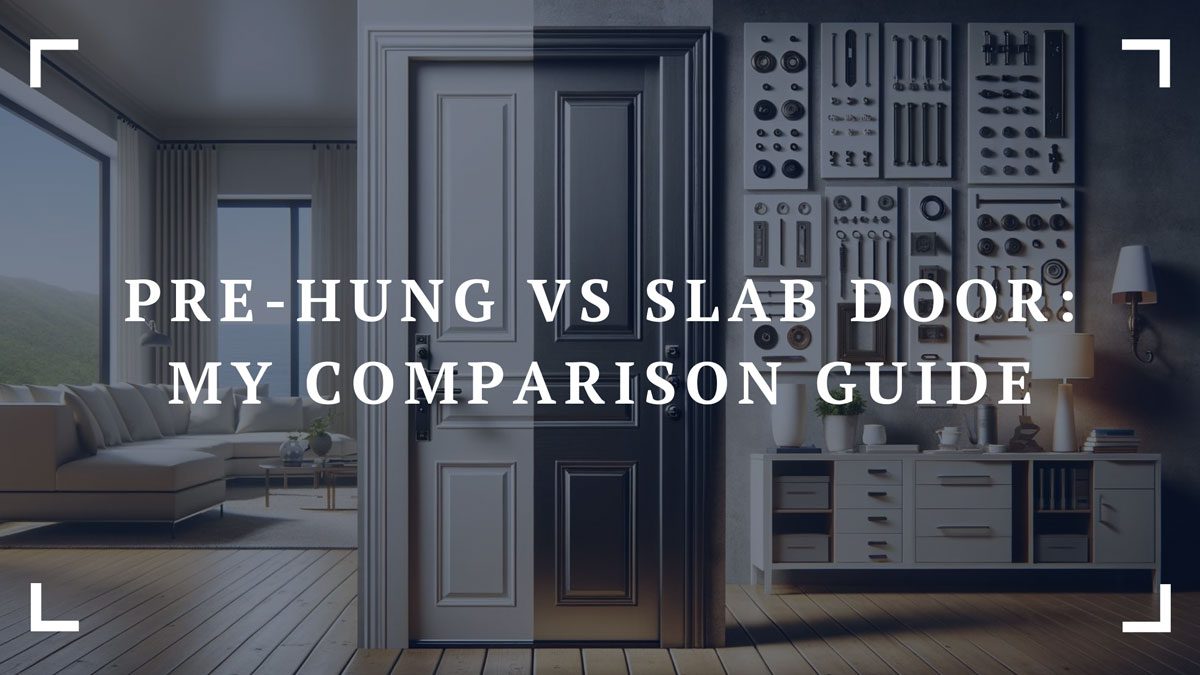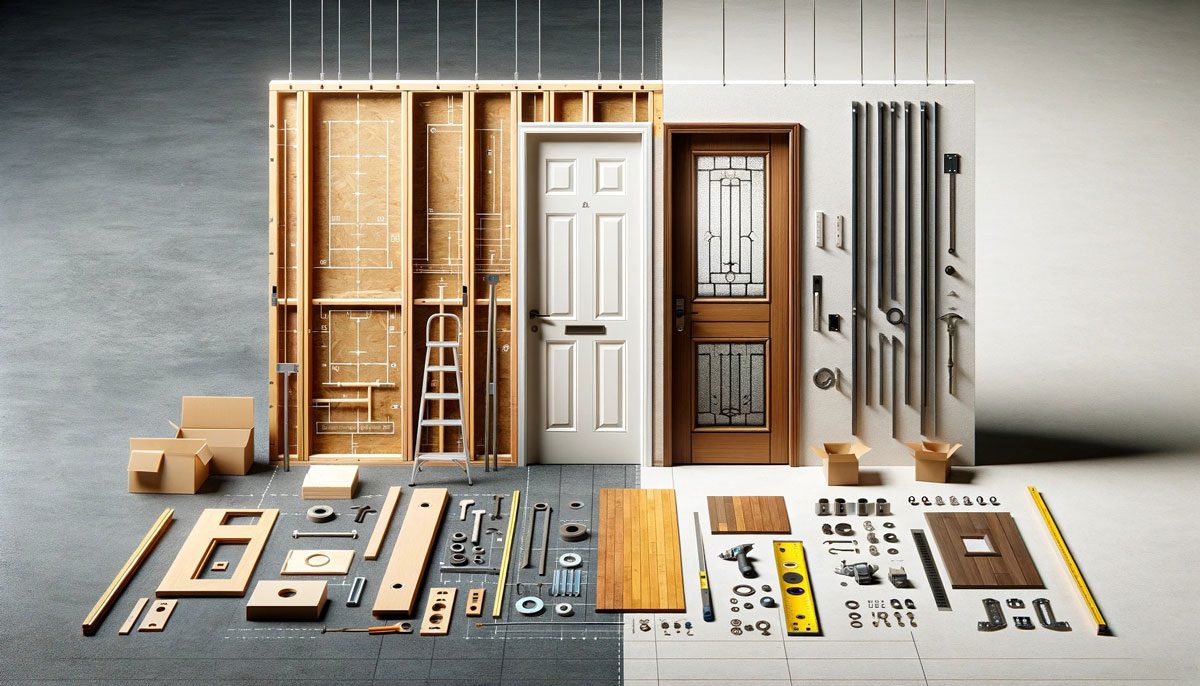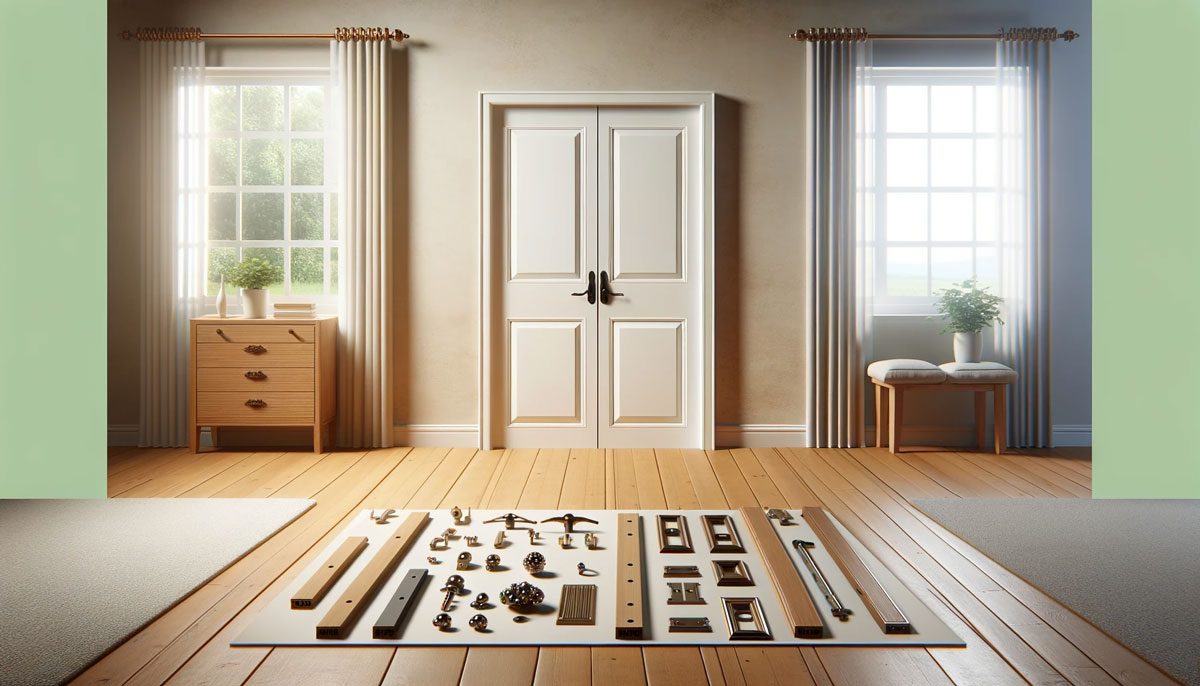Did you know that choosing between a pre-hung and slab door can affect not just the look of your home, but also its functionality? When I first dove into the world of doors, I was baffled by the choices. Pre-hung doors come as a complete package with frame and all, making them a breeze to install if you’re starting from scratch or doing a major renovation. On the flip side, interior slab doors are just the door itself, offering a canvas for those who love customization and have an existing frame in good shape. Deciding which one fits your project can be a head-scratcher, but fear not! I’ve gone down this road and am here to share the scoop on picking the right door type for your space.

What Are Pre-Hung Doors?
Pre-hung doors come as complete units. They include the door slab, hinges, and frame. This makes them ready to install upon arrival.
I find this feature incredibly helpful during my home renovation projects. It saves me time and effort, making the process smoother.
Easy Installation
Their installation is straightforward, especially in new construction or major renovations. Pre-hung doors eliminate the need to build a frame from scratch.
From personal experience, choosing pre-hung doors for my new build was a game-changer. It significantly reduced the complexity of the project.
Hardware Included
All necessary hardware and parts for installation come with these doors. This includes locks, handles, and other essential components.
Having everything included means I don’t have to worry about missing pieces or compatibility issues. It’s a relief knowing that all components are designed to work together seamlessly.
What Are Slab Doors?
Slab doors are simple. They come as single door slabs without any hardware, hinges, or frame attached. This makes them a blank canvas for homeowners. You can choose any doorknob, lockset, or hinge that fits your style.
I find this flexibility great for matching old doors in my home. It allows me to maintain a consistent look throughout, even when I need to replace a door.
Customization Options
With slab doors, the sky’s the limit for customization. Since they come bare, you can pick your own hardware and design. Whether it’s a unique doorknob or an antique lockset, slab doors let you personalize every detail.
For my latest project, I chose an old-fashioned doorknob that perfectly matched my home’s vintage theme. It was satisfying to see how well it blended with the rest of my decor.
Installation Needs
Installing a slab door requires an existing doorframe or the construction of a new one. You might need to chisel out a hole for the knob and create openings for the lockset and strike plate. This process demands some carpentry skills.
In my experience, ensuring the door fits perfectly in the opening is crucial. It took me some time to adjust the size of my slab door to fit an old wall opening at home.
Key Differences Highlighted

Pre-hung doors come with frames included, making them ready to install right out of the box. This means less time and effort for you or the installer. For someone like me who values time over money, choosing pre-hung doors for my house renovation was a no-brainer. They saved me a lot of hassle.
Slab doors, on the other hand, require more work. You need to buy and fit hardware, trim, and sometimes even carve out spaces for hinges. This task can be daunting for beginners and might require professional help, adding to the cost.
Customization Scope
Slab doors offer more flexibility in customization. You can pick from various sizes and types, tailoring them to your home’s unique style. I’ve always enjoyed this aspect since it allows me to add a personal touch to each room in my house.
Pre-hung doors come as complete packages. Their sizes and styles are predetermined by the brand, offering less room for customization. This might limit your options but ensures consistency throughout your home.
Project Suitability
Pre-hung doors are ideal for new constructions or when existing frames are damaged beyond repair. Their all-in-one nature simplifies the installation process in these scenarios.
Slab doors fit well in projects where the frame is still in good condition. They allow you to update your home’s look without replacing everything around the door.
Pros of Pre-Hung Doors
Pre-hung doors come with everything needed for installation. This means the door frame, hinges, and often the door knob are all included. For me, this was a game-changer when I renovated my home last year. It saved me from the trouble of purchasing separate components.
With pre-assembled parts, there’s less room for error. This reduces the risk of improper installation. I remember feeling relieved knowing that everything was designed to fit together perfectly.
Time Saving
For large projects, pre-hung doors are a time-saver. They allow for quicker installation compared to slab doors. This is because you don’t have to hang each component separately.
In my experience working on a friend’s house renovation, we chose pre-hung doors for this very reason. It significantly cut down our project time.
Reduced Risk
The pre-assembly of these doors minimizes the chance of incorrect installation. Since the frame and door are aligned by professionals before they reach you, it’s less likely you’ll encounter issues.
I’ve seen first-hand how a misaligned slab door can cause problems. It convinced me that pre-hung doors were worth considering for their precision alone.
Cons of Pre-Hung Doors
Pre-hung doors often come with a heavier price tag compared to slab doors. This is because they include not just the door itself, but also the frame and necessary hardware for installation. The added components can significantly increase the overall cost.
For me, this was a critical factor when renovating my home. I had to carefully balance my budget and the convenience that pre-hung doors offer. It’s essential for homeowners to consider this aspect, especially if working within a tight budget.
Difficult Handling
These doors are bulkier and heavier due to the pre-attached frame. Transporting and maneuvering them can be challenging, particularly in tight spaces or up stairs.
I remember struggling to fit a pre-hung door through a narrow hallway in my house. It was an exhausting process that made me question my choice initially. This experience taught me the importance of measuring spaces and planning paths before making a purchase.
Limited Customization
Pre-hung doors offer fewer customization options since they come as a complete set. For those looking to achieve a unique look or match specific design elements, this can be limiting.
In my quest for a perfect door, I found the lack of customization options frustrating. I wanted something that would stand out and complement my home’s aesthetic, which led me to explore slab doors as an alternative.
Advantages of Slab Doors
Slab doors are less expensive than pre-hung options. This is because they come without frames or hardware. For someone on a tight budget, like me, saving money where possible is crucial. I found that choosing a slab door allowed me to allocate funds elsewhere in my home renovation project.
They offer significant savings. This makes them appealing for large-scale projects or when updating several doors at once.
Customization
Another advantage is the high level of customization. Homeowners can achieve a unique look by selecting specific designs, materials, and finishes. My neighbor painted her slab door with a vibrant color and added vintage hardware, creating a standout piece that reflects her personality.
This flexibility allows for creativity. You’re not limited to standard sizes or styles.
Easy Handling
Slab doors are lighter and smaller without the frame and hardware. This makes them easier to transport and handle during installation. I remember carrying mine up the stairs without breaking a sweat, something I couldn’t have done with a pre-hung door.
Their size and weight benefit DIY enthusiasts. It simplifies the installation process significantly.
Disadvantages of Slab Doors
Slab doors require accurate measurements and cutting to fit existing frames. This process can be tricky. If measurements are off, the door won’t fit properly.
I once tried installing a slab door in my home. Despite my careful measuring, it took several adjustments before it fit right. This experience showed me the importance of precision.
Additional Costs
Buying and installing hardware separately adds to the cost. Hinges, knobs, and locks are sold separately for slab doors. This increases your expenses.
From my experience, finding matching hardware was not only costly but also time-consuming. It made me appreciate pre-hung doors’ convenience.
Professional Installation
The complexity of installing slab doors often requires professional help. This can lead to higher overall costs.
Many friends have shared stories of struggling with slab door installations. They ended up hiring professionals, which significantly increased their project costs.
Making the Right Selection

Before choosing between a pre-hung and slab door, it’s crucial to assess your project’s specific needs. Think about your budget, how much time you can dedicate, and if you want something custom.
Pre-hung doors might cost more but save time and hassle during installation. They come with a frame, hinges, and sometimes even hardware. This makes them a good choice for new constructions or when the existing frame is damaged.
Slab doors require more work. You need to have the right tools to install hinges and possibly cut the door to size. But they allow for more customization in terms of size options and materials. For me, choosing a slab door for my last renovation was about wanting that custom fit and finish.
Structure Consideration
Consider the structure of your home. Is it new construction or are you renovating an existing space?
New buildings often benefit from pre-hung doors since there’s no existing casing to worry about. Renovations might lean towards slab doors, especially if keeping the original casing is important.
Pros and Cons
Weighing the pros and cons of each option is vital. Pre-hung doors may require less work initially but limit customization options. Slab doors offer more freedom in materials and design but demand extra effort in assembly.
In tight spaces, determining the correct swing configuration is essential regardless of door type. Also, keep weather needs in mind; certain materials withstand different climates better.
Summary
Choosing between pre-hung and slab doors feels like picking pizza toppings—everyone’s got a preference, and there’s no one-size-fits-all. I’ve walked you through the nitty-gritty of both, from the perks of pre-hung doors making installation a breeze to slab doors letting you flex your DIY muscles. It’s all about what fits your space, skills, and style. Remember, it’s not just a door; it’s the entry to your personal haven or that closet hiding your less-than-organized chaos.
What’s it gonna be for you? If you’re still on the fence, picture your project, consider the work you’re willing to put in, and how much you value customization. Whatever you choose, make it yours. And hey, if you’ve got questions or need a bit more guidance, don’t hesitate to reach out. Doors are more than just functional; they’re a statement. Make yours count.
Frequently Asked Questions
What’s the main difference between pre-hung and slab doors?
Pre-hung doors come with everything you need for installation – frame, hinges, and door. Slab doors are just the door itself, requiring you to handle the frame and hardware separately.
Why would I choose a pre-hung door over a slab door?
If you’re looking for ease of installation and a complete package, pre-hung is the way to go. It’s like buying a ready-to-eat meal versus cooking from scratch.
Are slab doors cheaper than pre-hung doors?
Yes, slab doors typically cost less because they don’t include the frame or hardware. Think of it as buying ingredients for a meal rather than a whole dish.
What are the advantages of choosing a slab door?
Slab doors offer flexibility in customization. You can pick your own hardware and frame to match your style, like tailoring an outfit to fit perfectly.
Can installing a pre-hung door be a DIY project?
Absolutely! If you’re handy and have basic tools, installing a pre-hung door can be a satisfying weekend project. It’s like assembling furniture but with more steps.
What are the downsides of slab doors?
The main challenge is the installation process. You’ll need to measure accurately and possibly cut the door to fit your existing frame, which can be tricky for beginners.
How do I know if I should choose a pre-hung or slab door?
Consider your skill level and what you already have in place. If you’re starting fresh or prefer convenience, go with pre-hung. If you love DIY challenges and customization, slab might be your path.


